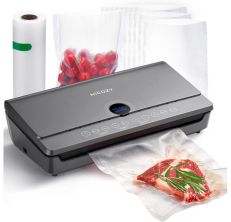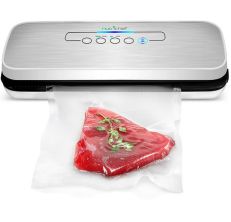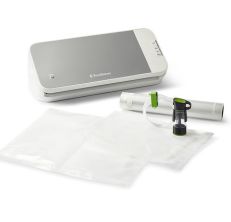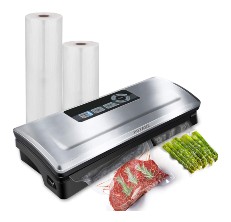This content was originally published on OldHouseOnline.com and has been republished here as part of a merger between our two businesses. All copy is presented here as it originally appeared there.
Vacuum sealers are a safe way to preserve foods for a longer period of time. There are a lot of vacuum sealer brands to choose from, so deciding on one can be challenging. One thing is for sure: you need one of the best vacuum sealers to ensure that you can live much more environmentally friendly with a greater focus on reducing food waste. Saving the environment has become more important than ever. In addition to helping create more sustainable practices, a vacuum sealer provides more space in the freezer and suitable packaging. Here are our top picks.
The Best Vacuum Sealer Models in Detail
MegaWise Vacuum Sealer
– Best Overall

Frozen food lasts a while, but when you vacuum seal food items before putting them in the freezer, they usually last 2-3 years on average. On average, most freezers and other storage methods can only store your food in good condition for 6-12 months. The MegaWise Vacuum Sealer Machine will keep your fresh foods free of decay and preserve them five times longer.
Pros
- Includes ten high-quality BPA-free vacuum bags
- Vacuums in 10-20 seconds and seals 3-5 bags at once
- Preserve dry and moist foods for five times longer
Cons
- May need an adapter or converter depending on your region
HiCOZY Vacuum Sealer
– Premium Choice

The HiCOZY Vacuum Sealer offers convenient features and customizable options to make your food-sealing process a breeze. With its unique magnetic auto-sealing technology, you no longer need to manually press the lids for sealing. The bag-locating markers ensure easy and precise bag placement, while the digital readout keeps you informed about the cycle’s progress.
One of the standout features is the adjustable sealing time, allowing you to effectively seal a variety of food items. Whether you’re sealing fresh meat, marinated meats, seafood with juice, or using thin vacuum bags, you can easily adjust the sealing time for a perfect seal every time.
This vacuum sealer caters to diverse needs with its multiple modes, including dry, moist, seal, canister, and manual. It gives you the flexibility to adjust suction power and sealing time for different types of food, such as meats, seafood, fruits, vegetables, nuts, and bread. It’s a versatile appliance that helps protect your food from freezer burn, reduces waste, and optimizes storage space.
Pros
- Magnetic auto-sealing for easy use
- Adjustable sealing time for customized sealing
- Multiple modes cater to different food needs
Cons
- Instructions can be confusing
NutriChef Vacuum Sealer
– Runner Up

Wet foods and the suction that comes in a vacuum bag can react negatively to each other, so you need a vacuum sealer like the NutriChef PKVS Vacuum Sealer that preserves dry and wet foods efficiently. The vac sealer has two options for sealing: One that seals the bags without vacuuming and another that combines vacuuming and sealing. We recommend getting this one because when it comes to kitchen appliances, NutriChef hardly disappoints.
Pros
- Lightweight and compact design
- Straightforward to use
- Affordable and efficient machine
Cons
- Sealing can take up to two minutes to complete
FoodSaver Vacuum Sealer
– Honorable Mention

Vacuum sealers keep food fresher for a longer time and ensure that essential vitamins and minerals remain in the food. Thus, there are many advantages to such a machine as the portable FoodSaver® VS2150 Food Vacuum Sealer. The vacuum seal comes with a vacuum seal roll that effectively keeps foods sealed. You also have two quart-sized vacuum-seal bags in the product package and two gallon-sized vacuum seal bags as a starter pack. FoodSaver also saves you more trouble by providing a handheld sealer and an attachable hose.
Pros
- Roll storage and cutter bar are built-in
- Portable, lightweight, and durable design
- Seals all kinds of foods airtight
Cons
- May need an adapter or converter depending on your region
Potane Vacuum Sealer
– Also Consider

With four modes of operation and another four different ones for vacuum sealing, the Potane Vacuum Sealer Machine stands out from the rest. It has a design that slopes down to prevent foods with liquid content from drying out while being vacuumed. If you like to use the sous vide method when preparing your food, where the vacuum-packed food is immersed in a water bath with a certain temperature and long-term cooked.
The temperature is lower than with a standard form of cooking, and therefore you get some more tender food that retains all its minerals and vitamins. The Potane Vacuum Sealer Machine ensures that these do not smoke out when cooking.
Pros
- Brushless motors with advanced heating wires
- Four modes of operation and vacuum sealing
- 2-year hitch-free return guarantee and 5-year warranty
Cons
- Users may have compatibility problems due to the electrical plug
Buying Guide for the Best Vacuum Sealers
There are more and many good reasons why you should invest in an effective vacuum sealer that can seal your food in a bag without oxygen. However, the idea is quite briefly to extend the shelf life of your food while retaining its flavor and all the good nutrients. The tight packaging ensures a protective atmosphere for your food so that bacteria do not develop in the food, as they require oxygen before they can live. Therefore, extending the shelf life by up to five times is also possible if you provide a very tight seal. The vacuum sealer also ensures much more efficient storage of your food, as they will not take up as much space in, for example, a freezer. Here is all you need to know before buying one of the best vacuum sealers.
Why Do You Need a Vacuum Sealer in Your Kitchen?
There is a big difference between vacuum-packed foods and those that you place in ordinary freezer bags. For example, there is a risk of forming lactic acid bacteria and other disease-causing bacteria, such as listeria monocytogenes. However, the risk of, for example, mold and microorganisms are gone. With a vacuum sealer, you can thus ensure that hygiene is top-notch in your food. It is all about the vacuum sealer sucking all the oxygen out of the bag. The oxygen helps degrade the shelf life, and therefore, it must be completely removed before you store your food items. Then, the bag is sealed tightly so that no new oxygen can enter your food.
Better than just freezing
For example, if you freeze some meat with an excellent fat edge, it will become rancid over time. Oxygen can enter the everyday freezer bag and become harmful to your health. Also, the bags may negatively affect the taste of your foods.
The tight gasket prevents frost damage. It’s the process of freezing damage, which eats away at the quality of your food. You can reduce the risk of frost damage by sealing it with a vacuum sealer.
Compatible with the sous vide technique
The method is also very good if you like to use the sous vide method when preparing your food. Here, vacuum-packed food is immersed in a water bath at a certain temperature and long-term cooked.
The temperature is lower than with a standard form of cooking, and therefore you get some more tender food that retains all its minerals and vitamins. The vacuum sealer ensures that these do not smoke out, as is the case with, for example, the normal frying of steaks and vegetables, among other things.
How To Find the Best Vacuum Sealer for Your Home?
Vacuum sealers keep food fresher for a longer time and ensure that essential vitamins and minerals remain in the food. Thus, there are many advantages to such a machine. But before you go out for a vacuum sealer, there are some essential considerations that you should make so that you give yourself the best conditions to get the machine that best suits the needs of your family.
What Type of Vacuum Sealer Do You Need?
First, you should consider what type of vacuum sealers you are interested in. These come in different price ranges depending on whether you are looking for a chamber vacuum sealer or an external vacuum sealer.
Chamber vacuum sealer
A chamber vacuum sealer is often more expensive and takes up more space. However, one is extremely good at sealing the food optimally, as it comes with a powerful vacuum pump and a large chamber. This means that the packing also takes place quite easily and quickly. It is often used in restaurants, maintaining the same pressure across all seals.
External vacuum sealer
On the other hand, an external vacuum sealer is a bit cheaper, and it also takes up much less space in the kitchen. The experts recommend this to the average consumer, and it also works as it should. It works by placing the open end of the vacuum bag at the open end and then sealing it.
How Much Are You Willing To Spend on a Vacuum Sealer?
Price can vary a lot, depending on the type of machine you want. You can get a vacuum sealer for a few dollars, while you may have to pay a premium for high-quality ones. You must take note of the size and type to determine the final price. Ultimately, make sure to buy what you need.
What Foods Do You Plan on Vacuum Sealing?
It is possible to vacuum seal most types of food. However, some things are better to use the method for than others. Experts say that especially the more fragile foods, such as cuts of fish, should not be vacuum-packed. This is due to the pressure to which the food is subjected, which can help crush it. The foods that also need air, such as a burger, should not be vacuum-packed either, as this will help to ruin the final taste experience. The food will have a completely wrong texture, which can be challenging to relate to purely aesthetically, and therefore, it is also necessary to be aware of the disadvantages that can occur if you choose to vacuum-pack substances of a liquid nature.
The liquid foods and the suction that comes in a vacuum bag can react negatively to each other. Therefore, it is recommended by the experts that you freeze the liquid substance before vacuum-packing it if at all necessary.
Conclusion
Thus, there are several things you need to be aware of when buying a vacuum sealer for your home. However, you must find one that matches your needs so you get a user-friendly machine in terms of operation, wiping, cleaning, and storage for you and your family.
Vacuum Sealer FAQ
Q: What foods can I seal in a vacuum sealer?
A: You can vacuum seal pretty much whatever you fancy, but you need to handle it with care and in the correct manner. Before filling the bag with food items, check to see if it has any growths in it. If you find growths, make sure they are not too many, as this could affect the sealed food’s long-term preservation. Once you have vacuum sealed your meat or the like, you should put it in the freezer to be stored for another time. The liquid foods and the suction that comes in a vacuum bag can react negatively to each other. Therefore, it is recommended by the experts that you freeze the liquid substance before vacuum-packing it if at all necessary.
Q: Are Vacuum sealers environmentally friendly?
A: It’s just about finding the little tricks that can help increase one’s own efforts to accommodate the hard-pressed environment that we all help to burden a little bit more every single day forever. We must all make an effort, and no matter how small and insignificant it may seem, a vacuum sealer may be the effort you make to reduce the risk of severe climate change.
Q: How long before my vacuum-sealed food in the freezer goes bad?
A: Frozen food lasts a while, but when you vacuum seal food items before putting them in the freezer, they usually last 2-3 years on average. On average, most freezers and other storage methods can only store your food in good condition for 6-12 months.










